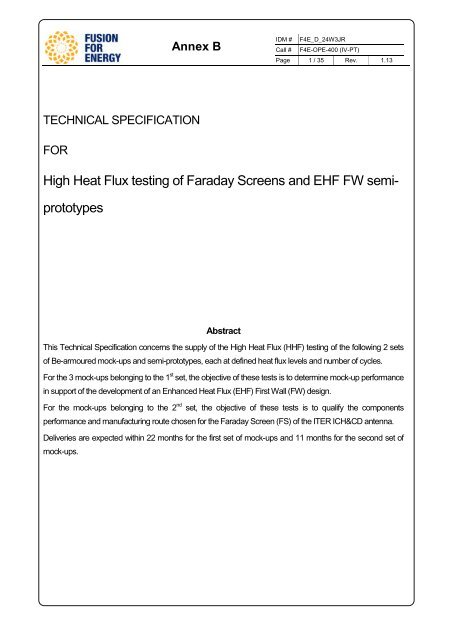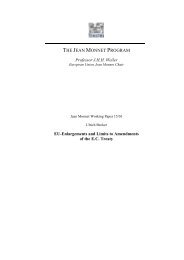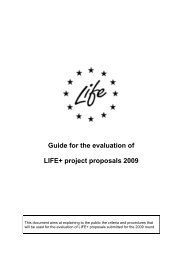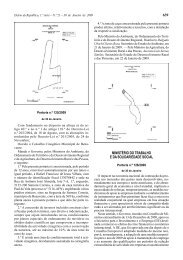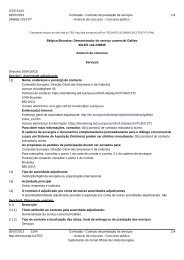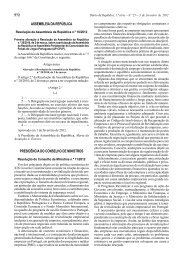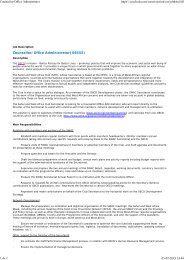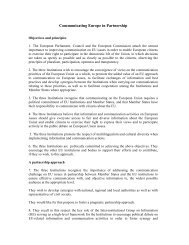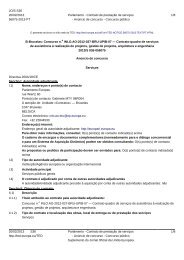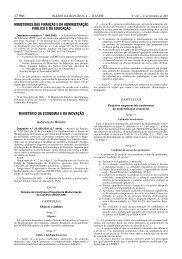Annex B
Annex B
Annex B
You also want an ePaper? Increase the reach of your titles
YUMPU automatically turns print PDFs into web optimized ePapers that Google loves.
<strong>Annex</strong> BIDM # F4E_D_24W3JRCall # F4E-OPE-400 (IV-PT)Page 2 / 35 Rev. 1.13Table of Contents1. INTRODUCTION ............................................................................................................................................................................. 31.1. Introduction to ITER & Fusion for Energy .............................................................................................................................. 31.2. Subject of this Technical Specification ................................................................................................................................... 42. SCOPE OF THE TENDER/PROPOSAL .................................................................................................................................... 52.1. Scope of supply ........................................................................................................................................................................ 52.1.1. General ............................................................................................................................................................................. 52.1.2. Services ............................................................................................................................................................................ 52.1.3. Miscellaneous .................................................................................................................................................................. 62.2. Items supplied by F4E ............................................................................................................................................................. 62.2.1. Beryllium Test samples ................................................................................................................................................ 133. TECHNICAL REQUIREMENTS ................................................................................................................................................. 143.1. Engineering activities/studies/test/studies ............................................................................................................................ 143.1.1. Studies to be performed ............................................................................................................................................... 143.1.2. Software/ Computer programmes .............................................................................................................................. 143.1.3. Test protocol .................................................................................................................................................................. 143.1.4. Test programme and conditions .................................................................................................................................. 153.1.5. Measurements and data recording ............................................................................................................................. 283.2. Test facility ............................................................................................................................................................................... 293.2.1. Absorbed power accuracy ........................................................................................................................................... 293.2.2. Test facility qualification ................................................................................................................................................ 294. LOGISTIC SUPPORT REQUIREMENTS................................................................................................................................. 304.1. Shipment of samples, mock-ups and semi-prototypes to the test facility premises for HHf testing .............................. 304.2. Shipment of samples, mock-ups and semi-prototypes from the test facility premises to a location in France ............ 305. LONG TERM CONDITIONS ....................................................................................................................................................... 306. APPLICABLE DESIGN REFERENCES ................................................................................................................................... 316.1. Safety and regulatory requirements ..................................................................................................................................... 317. DELIVERABLES AND SCHEDULING ..................................................................................................................................... 328. QUALITY ASSURANCE PROVISIONS ................................................................................................................................... 339. IDENTIFICATION REQUIREMENTS ........................................................................................................................................ 33APPENDIX 1 – TENTATIVE TIME SCHEDULE .......................................................................................................................... 34
<strong>Annex</strong> BIDM # F4E_D_24W3JRCall # F4E-OPE-400 (IV-PT)Page 3 / 35 Rev. 1.13TERMS AND DEFINITIONSTerm Definition AcronymAcceptance DataIs the documentation package linked with a deliverable to be submitted by the supplierPackageFusion for Energy The European Joint Undertaking for ITER and the Development of Fusion EnergyTechnicalResponsibleOfficerADPTROF4E’s responsible for communicating all technical contractual actions and decisions to theSupplierQuality Officer F4E’s responsible for QA for the Contract QAOIO ITER Organisation sometimes referred to as ITER IOKOM Kick-Off Meeting of the Contract KOMSubcontractor All economic operators who supply items to the Supplier under the Contract ---SupplierThe supplier is either:the Contractor as defined in the supply or service Contract, orthe Beneficiary as defined in the Grant Agreement.The successful Bidder (Tenderer or Applicant) is referred in the document as the “supplier”.The supply-chain follows the scheme belowSupplier -> Organization (F4E) -> Customer (e.g. IO )F4E---1. INTRODUCTION1.1. INTRODUCTION TO ITER & FUSION FOR ENERGYThe ITER project aims to build a fusion device, twice the size of the largest current devices, with the goal ofdemonstrating the scientific and technical feasibility of fusion power. It is a joint project between the EuropeanUnion, China, India, Japan, South Korea, the Russian Federation and the USA. ITER will be constructed inEurope, at Cadarache in the south of France.Most of the components that make up the ITER project are to be manufactured by each of the participatingcountries and contributed in kind through so-called Domestic Agencies including Fusion for Energy. In manycases the engineering and technologies required to manufacture these components are very advanced.The European Joint Undertaking for ITER and the Development of Fusion Energy or 'Fusion for Energy' is atype of European organisation known as a Joint Undertaking created under the Euratom Treaty by adecision of the Council of the European Union.'Fusion for Energy' has three main objectives:Providing European contributions to the ITER international fusion energy research project being builtin Cadarache, France;Providing European contributions to a number of joint projects with Japan that aim to accelerate thedevelopment of fusion - the "Broader Approach";Coordinating a programme of activities to prepare for the first demonstration fusion reactors that cangenerate electricity (DEMO).
<strong>Annex</strong> BIDM # F4E_D_24W3JRCall # F4E-OPE-400 (IV-PT)Page 4 / 35 Rev. 1.131.2. SUBJECT OF THIS TECHNICAL SPECIFICATIONThis Technical Specification applies to the performance of high heat flux (HHF) testing of the Be/CuCrZr/SSFirst Wall (FW) and Faraday Screen (FS) mock-ups manufactured by a fabrication route where bondingbetween the different materials (essentially SS, CuCrZr and beryllium) is obtained by using the HIPpingtechnology.The overall testing activity is subdivided into 2 tasks:Task 1: For a first set of 3 mock-ups, the objectives of these tests are to determine mock-up performanceunder thermal fatigue in support of the development of an Enhanced Heat Flux (EHF) FW design.Task 2: For the mock-ups belonging to the 2 nd set, the objectives of these tests are to qualify the design of theFS of the ICH&CD antenna, through thermal fatigue tests. The mock-ups will be provided by F4E at differentperiod of time in the course of this contract.See appendix 1 for a tentative time schedule, giving to tenderer an indication of when the various tests couldpossibly take place.
<strong>Annex</strong> BIDM # F4E_D_24W3JRCall # F4E-OPE-400 (IV-PT)Page 5 / 35 Rev. 1.132. SCOPE OF THE TENDER/PROPOSAL2.1. SCOPE OF SUPPLY2.1.1. GENERALThe Supplier shall perform a series of High Heat Flux (HHF) tests on small scale mock- and semi-prototypes,subdivided in the 2 following Tasks:‣ Task 1 : First Wall mock-ups and semi-prototypeoooSub-Task 1.1: HHF testing of 1 small scale heat sink mock-up, made of SS and Copperalloy, to determine the performance of the heat sink designSub-Task 1.2: HHF testing of 1 small scale Be-coated mock-up to determine theperformance of the EHF design under thermal fatigue,Sub-Task 1.3: HHF testing of 1 Be coated semi-prototype to determine the performance ofthe EHF design under thermal fatigue with cycles and heat loads as defined below,‣ Task 2 : Faraday screen of the ICRH antennaoooSub-Task 2.1: HHF testing of 2 small scale mock-ups, made of SS and Copper Alloy, todetermine the performance of the heat sink design,Sub-Task 2.2: HHF testing of 2 Be coated Small Scale Mock-Ups to determine theperformance of the FS design under thermal fatigue,Sub-Task 2.3: HHF testing of 1 Be coated FS prototype assembly to determine theperformance of the FS bars and attachments under thermal fatigue.2.1.2. SERVICESThe proposed work shall include the following activities:‣ 3D FEM thermo-mechanical analyses of the configurations tested in Task 1 (estimated at up to 4man months), including final comparative studies between the experimental and theoretical results,‣ Performance of screening tests and calorimetry on test samples of Beryllium to determine preciselythe emissivity and the absorption coefficient of beryllium surface under different conditions of surfaceand of temperature,‣ Preparation of the mock-ups prior to testing, including in particular the installation of thethermocouples as specified in the mock-up drawings,‣ Storage of the mock-ups in clean and dry conditions prior to and after testing, up to 6 months,‣ Performance of screening tests and calorimetry at the required test conditions to ensure the accuratemeasurement of the absorbed heat by the mock-ups,
<strong>Annex</strong> BIDM # F4E_D_24W3JRCall # F4E-OPE-400 (IV-PT)Page 6 / 35 Rev. 1.13‣ Performance of the heat flux tests as specified,‣ Processing of the test data and full reporting of the results,‣ Issue of all necessary procedures,‣ Decontamination of the mock-ups from Be after completion of the tests and before dispatching,‣ Shipments of samples, mock-ups and semi-prototypes, instructed by F4E, which shall be done inaccordance with health and safety regulations applied for Be containing parts in the country(ies) oftransit and destination and also in accordance with applicable export control regulations. Shipmentsto be considered are:ooFrom a site in France to the HHF test facility premisesFrom the HHF test facility premises to a site in France2.1.3. MISCELLANEOUSThe following is also part of the scope of supply:Cleaning and preparation for packing before shipment,Contract management as required by F4E,Test facility visits,2.2. ITEMS SUPPLIED BY F4EThe mock-ups and semi-prototypes to be tested shall be made available by F4E EXW (INCOTERMS 2010)at a location in France. They consist of a structure made by a Cu alloy layer joined onto a 316L SS backingplate. They are cooled by means of rectangular copper tubes embedded into the structure. A Beryllium(layer) is joined to the Cu alloy heat sink material in form of tiles. The main dimensions of the mock-ups are:‣ Sub-Task 1.1: 1 FW heat sink mock-up : ~50 x 550 mm, similar as the Be mock-up but without Be tiles see Figure 2and Figure 3.‣ Sub-Task 1.2: 1 FW Be mock-up: ~50 x 550 mm, see Figure 4 and Figure 5.‣ Sub-Task 1.3: 1 FW semi-prototype: ~300 x 700 mm, see Figure 6 and Figure 7.‣ Sub-Task 2.1:2 FS heat sink mock-ups: around 420 x 30 mm, similar to the FS mock-ups with Be, but without Betiles (see Figure 8 and Figure 9). The water inlet and outlet pipes will be 14mm inner diameter and16mm outer diameter. Detailed dimensions to be clarified at the KoM.‣ Sub-Task 2.2:
<strong>Annex</strong> BIDM # F4E_D_24W3JRCall # F4E-OPE-400 (IV-PT)Page 7 / 35 Rev. 1.132 FS mock-ups: ~ 420 x 30 mm, see Figure 8 and Figure 9. The water inlet and outlet pipes will be14mm inner diameter and 16mm outer diameter. Detailed dimensions to be clarified at the KoM.‣ Sub-Task 2.3:1 prototype assembly with 4 to 6 FS prototype bars: around 400 x 500 mm, see Figure 10. Detaileddimensions to be clarified at the KoM.More detailed information on the dimensions of the mock-ups will be further made available at the latest atthe KoM. Any change of dimension of small entity that could have occurred for any reasons shall still beconsidered by Supplier as included in the specifications; Supplier shall have provisions in this contract tocover any adaptation to fit to the final dimensions of the components that will be delivered.The mock-up of the Sub-Task 1.2 will have six penetrations machined as close as possible to the CuCrZr/Beinterface for the installation of thermocouples. Thermocouples will then be installed before placing the mockupinside the test facility.For the semi-prototype of the Sub-Task 1.3, provisions will be foreseen for installing 24 thermocouples.The mock-ups of Sub-Task 2.1 and Sub-Task 2.2 will have three penetrations for the installation ofthermocouples.. Thermocouples will then be installed before placing the mock-up inside the test facility.For the prototype assembly of the Sub-Task 2.2, provisions will be foreseen for installing up to 20thermocouples (the exact number will be confirmed at the Kick off Meeting).Figure 1 - Typical finger cross-section of the enhanced heat flux (EHF) FW design with rectangular cooling channels
<strong>Annex</strong> BIDM # F4E_D_24W3JRCall # F4E-OPE-400 (IV-PT)Page 8 / 35 Rev. 1.13Figure 2 - FW heat sink mock-up - 3D viewFigure 3 - FW heat sink mock-up – dimensions
<strong>Annex</strong> BIDM # F4E_D_24W3JRCall # F4E-OPE-400 (IV-PT)Page 9 / 35 Rev. 1.13Figure 4 - FW Be mock-up - 3D viewFigure 5 - FW Be mock-ups - dimensions
<strong>Annex</strong> BIDM # F4E_D_24W3JRCall # F4E-OPE-400 (IV-PT)Page 10 / 35 Rev. 1.13Figure 6 - Typical 3D scheme of the EHF FW semi-prototype
<strong>Annex</strong> BIDM # F4E_D_24W3JRCall # F4E-OPE-400 (IV-PT)Page 11 / 35 Rev. 1.13Figure 7 - EHF FW Semi-prototype front, side and rear views
<strong>Annex</strong> BIDM # F4E_D_24W3JRCall # F4E-OPE-400 (IV-PT)Page 12 / 35 Rev. 1.13Figure 8 - Typical FS Mock-Up and prototype cross-section with rectangular cooling channelsFigure 9 - Typical FS Mock-Up arrangement
<strong>Annex</strong> BIDM # F4E_D_24W3JRCall # F4E-OPE-400 (IV-PT)Page 13 / 35 Rev. 1.13Figure 10 – Typical arrangement and dimension of the FS prototype assembly.2.2.1. BERYLLIUM TEST SAMPLESPerformance of tests on samples of Beryllium to determine precisely the emissivity and the absorptioncoefficient of beryllium surface under different conditions of surface and of temperature shall be performed bythe Supplier. The Beryllium test samples will be provided by F4E (up to 6 Be samples). The approximatedimensions of the Be samples will be 50 x 50 x 6 mm.The dimensions, the surface conditions and the number of the Be samples will be further defined at the latestat the KoM. It is therefore intended that Supplier shall accept to use samples of different dimensions.
<strong>Annex</strong> BIDM # F4E_D_24W3JRCall # F4E-OPE-400 (IV-PT)Page 14 / 35 Rev. 1.133. TECHNICAL REQUIREMENTS3.1. ENGINEERING ACTIVITIES/STUDIES/TEST/STUDIES3.1.1. STUDIES TO BE PERFORMEDThe Supplier shall perform 3D FEM thermo-mechanical analyses of the tested geometries in Task 1 only.Correlations shall be used to determine the hydraulic parameters. At the interface Be/CuCrZr the followingparameters shall be calculated: cumulative plastic strain, normal and shear stress, and stress triaxiality.Temperature and VM stress distribution shall be calculated for the whole mock-up. The objective of theseanalyses is to support the understanding of the results of the tests. First an analysis shall be performed foreach geometry to evaluate the expected results in terms of temperature and stress distribution after 5 cyclesand to evaluate the evolution of the drivers of the failure initiation, i.e. cumulative plastic strain, normal andshear stress, and stress triaxiality. After the test, the model shall be modified, after approval of themodifications by F4E, to improve the consistency with the results.The scope of the studies will be further defined at the latest at the KoM.3.1.2. SOFTWARE/ COMPUTER PROGRAMMESThe software used for the thermo-mechanical analyses of the tested geometries shall be ANSYS. In caseANSYS is not available, alternative software may be proposed by Supplier to F4E for review andacceptance.3.1.3. TEST PROTOCOLThe general rules, which are applicable to the High Heat Flux testing activity, are described hereinafter.The specified value for the heat flux shall be intended as “target value for the absorbed heat flux” with a flatprofile. A heat flux profile is defined as “flat” when its variation is within ±5% of its average value when appliedonto a flat surface. 1The absorbed heat flux shall be within ±5% of the target value. If, for any reason, this proves to beimpractical, the test operator shall immediately inform F4E of the reasons why the target value cannot beachieved.The tests shall utilise a mask over the required surfaces to ensure a flat beam profile.For Sub-Task 1.2, a 1 MW/m 2 heat flux screening cycle shall be applied to the Be surface area pre and postthermal fatigue phases. The entire area covered by Beryllium on the mock up shall be subject of the highheat flux testing.1 The tolerance of ±5% on the flatness of the heat flux profile should be easily achieved with an electron beam gun.
<strong>Annex</strong> BIDM # F4E_D_24W3JRCall # F4E-OPE-400 (IV-PT)Page 15 / 35 Rev. 1.13For Sub-Task 1.3 a 1 MW/m 2 heat flux shall be applied to not less than 90% of the Be surface area asdefined below for all thermal screening cycles.For Sub-Tasks 2.2 and 2.3 a 1 MW/m 2 heat flux screening cycle shall be applied to the Be surface area. See§3.1.4 for further requirement on screening tests for Task 2.A detailed test procedure and a detailed calibration procedure, including the water calorimetry part, shall beprepared by the Bidder as part of the offer.A Test Protocol including at least the following main test parameters shall be issued to and confirmed by F4Ebefore each test starts:Surface heat flux and profile,Pulse length and dwell time,Hydraulic conditions (water coolant flow rate, temperature and pressure),Cross check of all temperature measuring devices,Maximum heat flux during the initial screening.For Sub-Task 1.3 and Task 2, before the starting of each test a Test Protocol shall be issued by the Supplierand approved by F4E (Hold Point). This document shall describe:The positions of the semi-prototype and the labelling of heated areas for each step of test (thermalscreening and cycling steps),The testing parameters for each position (hydraulics, electron beam),The main measurements which have to be performed during the test,The main probable scenarios of tile failure and the related reduction of the heated surface,All the information required for the execution of the test.3.1.4. TEST PROGRAMME AND CONDITIONSThe identifiers of the components to be tested shall be given at the start of the Task. These identifiers shallbe the basis of monitoring of the individual components throughout their stay at the facility.If so requested by the supplier, the maximum temperature on the surface of the Be tiles may be limited to700 C. No limit below this point is acceptable.
<strong>Annex</strong> BIDM # F4E_D_24W3JRCall # F4E-OPE-400 (IV-PT)Page 18 / 35 Rev. 1.13Test conditions for Sub-Sub-Task 1.3.1Thermal fatigue cycling shall be applied as described below and in the Table 1, Table 2 and Figure 11.ooNominally 3 test zones will be required to complete the total required number of fatigue cycles,The area for application of the heat flux shall sit within the red, yellow and blue zones.Table 1 - Test levels for Sub-Sub-Task 1.3.1EHFprototypesemiInitial Thermalscreening CycleCalibration See 3.2.1Phase 1a (Step 1)Phase 1b (Step 1)IntermediateThermal screeningCalibration See 3.2.1Phase 2FinalscreeningThermalCalibration See 3.2.1Heat Flux and cyclesCycleduration*0.5 MW/m 2 SufficientforSteadyState6000 cycles30 s/ 30*2.4 MW/m 2 s on/off6000 cycles30 s/ 30*2.4 MW/m 2 s on/off*0.5 MW/m 2 SufficientforSteadyState3000 cycles30 s/ 30*3 MW/m 2 s on/off*0.5 MW/m 2 SufficientforSteadyState30 s/ 30Additional cycling *Incremental steps of 0.14 MW/m 2MW/m 2 of 100 cycles s on/offeach from 3 MW/m 2 up toArea90% of SPBerylliumsurfaceBlue zone +Yellow zoneRed zone +Yellow zone90% of SPBerylliumsurfaceThe maximumarea includingthe YellowZone90% of SPBerylliumsurfaceThe maximumarea includingthe YellowZoneTest conditionsOutlet temperature 150°C ± 5°CInlet Pressure 3MPa ±5%Flow Rate 3 kg/s ±5%*Outlet temperature 150°C ± 5°CInlet Pressure 3MPa ±5%Flow Rate 3 kg/s ±5%*Outlet temperature 150°C ± 5°CInlet Pressure 3MPa ±5%Flow Rate 3 kg/s ±5%*Outlet temperature 150°C ± 5°CInlet Pressure 3MPa ±5%Flow Rate 3 kg/s ±5%*5%Outlet temperature 150°C ± 5°CInlet Pressure 3MPa ±5%Flow Rate 3 kg/s ±5%*Outlet temperature 150°C ± 5°CInlet Pressure 3MPa ±5%Flow Rate 3 kg/s ±5%*Outlet temperature 150°C ± 5°CInlet Pressure 3MPa ±5%Flow Rate 3 kg/s ±5%*
<strong>Annex</strong> BIDM # F4E_D_24W3JRCall # F4E-OPE-400 (IV-PT)Page 19 / 35 Rev. 1.13Note* Flow rate: some modification to this value may be necessary for the thermal loads specifiedTable 2 - Requirements for % Be coverage v cycles v heat flux for Sub-Sub-Task 1.3.1Step Flux (MW/m 2 ) Required cycles Minimum % coverage of Be surface1a Blue 2.4 6000 Total area covered by step 1> 50%1b Red 2.4 60002 Yellow 3 300012000 cycles accumulatedfor an overlap area >7%(yellow area)Total cycles applied 15000 > 7% of Be surface (yellow)Figure 11 - Possible implementation for application of heat flux to meet coverage requirements for Sub-Sub-Task 1.3.1
<strong>Annex</strong> BIDM # F4E_D_24W3JRCall # F4E-OPE-400 (IV-PT)Page 20 / 35 Rev. 1.13Test conditions for Sub-Sub-Task 1.3.2Thermal fatigue cycling shall be applied as described below and in the Table 3, Table 4 and Figure 12.ooNominally 3 test zones will be required to complete the total required number of fatigue cycles,The area for application of the heat flux shall sit within the red, yellow and blue zones.Table 3 - Test levels for Sub-Sub-Task 1.3.2EHFprototypesemiInitial Thermalscreening CycleCalibration See 3.2.1Phase 1a (Step 1)Phase 1b (Step 1)IntermediateThermal screeningCalibration See 3.2.1Phase 2FinalscreeningThermalCalibration See 3.2.1Heat Flux and cyclesCycleduration*0.5 MW/m 2 SufficientforSteadyState6000 cycles30 s/ 30*3 MW/m 2 s on/off6000 cycles30 s/ 30*3 MW/m 2 s on/off*0.5 MW/m 2 SufficientforSteadyState3000 cycles30 s/ 30*3.75 MW/m 2 s on/off*0.5 MW/m 2 SufficientforSteadyStateAdditional cycling *Incremental steps of 0.1 30 s/ 30MW/m 2 of 100 cycles s on/offeach from 3.75 MW/m 2up to 4.75 MW/m 2Area90% of SPBerylliumsurfaceBlue zone +Yellow zoneRed zone +Yellow zone90% of SPBerylliumsurfaceThe maximumarea includingthe YellowZone90% of SPBerylliumsurfaceThe maximumarea includingthe YellowZoneTest conditionsOutlet temperature 150°C ± 5°CInlet Pressure 3MPa ±5%Flow Rate 3 kg/s ±5%*Outlet temperature 150°C ± 5°CInlet Pressure 3MPa ±5%Flow Rate 3 kg/s ±5%*Outlet temperature 150°C ± 5°CInlet Pressure 3MPa ±5%Flow Rate 3 kg/s ±5%*Outlet temperature 150°C ± 5°CInlet Pressure 3MPa ±5%Flow Rate 3 kg/s ±5%*5%Outlet temperature 150°C ± 5°CInlet Pressure 3MPa ±5%Flow Rate 3 kg/s ±5%*Outlet temperature 150°C ± 5°CInlet Pressure 3MPa ±5%Flow Rate 3 kg/s ±5%*Outlet temperature 150°C ± 5°CInlet Pressure 3MPa ±5%
<strong>Annex</strong> BIDM # F4E_D_24W3JRCall # F4E-OPE-400 (IV-PT)Page 21 / 35 Rev. 1.13Flow Rate 3 kg/s ±5%*Note* Flow rate: some modification to this value may be necessary for the thermal loads specifiedTable 4 - Requirements for % Be coverage v cycles v heat flux for Sub-Sub-Task 1.3.2Step Flux (MW/m 2 ) Required cycles Minimum % coverage of Be surface1a Blue 3 6000 Total area covered by step 1> 50%1b Red 3 60002 Yellow 3.75 300012000 cycles accumulatedfor an overlap area >7%(yellow area)Total cycles applied 15000 > 7% of Be surface (yellow)Figure 12 - Possible implementation for application of heat flux to meet coverage requirements for Sub-Sub-Task 1.3.2
<strong>Annex</strong> BIDM # F4E_D_24W3JRCall # F4E-OPE-400 (IV-PT)Page 22 / 35 Rev. 1.13Test conditions for Sub-Sub-Task 1.3.3Thermal fatigue cycling shall be applied as described below and in the Table 5, Table 6 and Figure 13.ooNominally 3 test zones will be required to complete the total required number of fatigue cycles,The area for application of the heat flux shall sit within the red, yellow and blue zones.Table 5 - Test levels for Sub-Sub-Task 1.3.3EHFprototypesemiInitial Thermalscreening CycleCalibration See 3.2.1Phase 1a (Step 1)Phase 1b (Step 1)IntermediateThermal screeningCalibration See 3.2.1Phase 2FinalscreeningThermalCalibration See 3.2.1Heat Flux and cyclesCycleduration*0.5 MW/m 2 SufficientforSteadyState6000 cycles30 s/ 30*4.6 MW/m 2 s on/off6000 cycles30 s/ 30*4.6 MW/m 2 s on/off*0.5 MW/m 2 SufficientforSteadyState3000 cycles30 s/ 30*5.75 MW/m 2 s on/off*0.5 MW/m 2 SufficientforSteadyStateAdditional cycling *Incremental steps of 0.1 30 s/ 30MW/m 2 of 100 cycles s on/offeach from 5.75 MW/m 2up to 6.75 MW/m 2Area90% of SPBerylliumsurfaceBlue zone +Yellow zoneRed zone +Yellow zone90% of SPBerylliumsurfaceThe maximumarea includingthe YellowZone90% of SPBerylliumsurfaceThe maximumarea includingthe YellowZoneTest conditionsOutlet temperature 150°C ± 5°CInlet Pressure 3MPa ±5%Flow Rate 3 kg/s ±5%*Outlet temperature 150°C ± 5°CInlet Pressure 3MPa ±5%Flow Rate 3 kg/s ±5%*Outlet temperature 150°C ± 5°CInlet Pressure 3MPa ±5%Flow Rate 3 kg/s ±5%*Outlet temperature 150°C ± 5°CInlet Pressure 3MPa ±5%Flow Rate 3 kg/s ±5%*5%Outlet temperature 150°C ± 5°CInlet Pressure 3MPa ±5%Flow Rate 3 kg/s ±5%*Outlet temperature 150°C ± 5°CInlet Pressure 3MPa ±5%Flow Rate 3 kg/s ±5%*Outlet temperature 150°C ± 5°CInlet Pressure 3MPa ±5%Flow Rate 3 kg/s ±5%*
<strong>Annex</strong> BIDM # F4E_D_24W3JRCall # F4E-OPE-400 (IV-PT)Page 23 / 35 Rev. 1.13Note* Flow rate: some modification to this value may be necessary for the thermal loads specifiedTable 6 - Requirements for % Be coverage v cycles v heat flux for Sub-Sub-Task 1.3.3Step Flux (MW/m 2 ) Required cycles Minimum % coverage of Be surface1a Blue 4.6 6000 Total area covered by step 1> 50%1b Red 4.6 60002 Yellow 5.75 300012000 cycles accumulatedfor an overlap area >7%(yellow area)Total cycles applied 15000 > 7% of Be surface (yellow)Figure 13 - Possible implementation for application of heat flux to meet coverage requirements for Sub-Sub-Task 1.3.3
<strong>Annex</strong> BIDM # F4E_D_24W3JRCall # F4E-OPE-400 (IV-PT)Page 24 / 35 Rev. 1.13Test conditions for Sub-Task 2.1 (FS SSMU without Be)The test conditions for the 2 FS small scale mock-ups are as follows:• inlet water coolant temperature: ≈ 80 °C• inlet water coolant pressure: ≈ 4 MPa (unless specifieddifferently below)• water flow velocity in the copper pipes: 8 m.s -1 (unless specifieddifferently below)• heat flux cycle: 15 sec on / 15 sec off• Number of cycles 10 at each power density• Surface heated > 80%• Surface heat flux 3, 6, 8, 10, 11, 11.5, 12, 12.5, 13,13.5 and 14MW/m²Test conditions for Sub-Task 2.2 (FS SSMU)The test conditions for the 2 FS small scale mock-ups are as follows:• inlet water coolant temperature: ≈ 80 °C• inlet water coolant pressure: ≈ 4 MPa (unless specifieddifferently below)• water flow velocity in the copper pipes: 8 m.s -1 (unless specifieddifferently below)• heat flux cycle: 15 sec on / 15 sec off• surface heat flux for the screening tests: 1.0 MW/m 2Sub-Sub-Task 2.2.115,000 cycles at 2.5 MW.m -2 absorbed power density, thermal screening before the first cycle,after 500 cycles, 5000 cycles and after the last cycle. 80% of the surface shall be tested (seeFigure 14).Figure 14 - Surface submitted (in red) to a 2.5 MW.m -2 heat flux during Sub-Sub-Task 2.2.1, for each FS mock-up
<strong>Annex</strong> BIDM # F4E_D_24W3JRCall # F4E-OPE-400 (IV-PT)Page 25 / 35 Rev. 1.13Sub-Sub-Task 2.2.215,000 cycles at 3.5 0.2 MW.m -2 absorbed power density, thermal screening after 500 cycles,5000 cycles and after the last cycle. This test shall be performed on 2 tiles only: 1 full tile and 2half tiles on each side (see Figure 15).Figure 15 - Surface submitted (in red) to a 3.5 MW.m -2 heat flux during Sub-Sub-Task 2.2.2 and 5 MW.m -2 during Sub-Sub-Task2.2.3, for each FS mock-upSub-Sub-Task 2.2.33,000 cycles at 5 0.2MW.m -2 absorbed power density, thermal screening after 500 cycles andafter the last cycle. This test shall be performed on the same surface as the previous step of test 2(see Figure 15). In addition, after the last thermal screening test, 10 cycles at 5.5MW.m -2 shall beperformed. This part of the test shall be performed on 2 tiles only (see Figure 17), with a watervelocity of 8 m.s -1 , and water pressure of 2.6 MPa.Sub-Sub-Task 2.2.415,000 cycles at 3.5 0.2 MW.m -2 absorbed power density with water flow of 5 m.s -1 , thermalscreening after 500 cycles, 5000 cycles and after the last cycle. This test shall be performed on 2tiles only: 1 full tile and 2 half tiles on each side. The tiles shall not have been those tested duringSub-Sub-Task 2.2.2 and 2.2.3 (see Figure 16).Figure 16 - Surface submitted (in red) to a 3.5 MW.m -2 heat flux during Sub-Sub-Task 2.2.4, for each FS mock-upSub-Sub-Task 2.2.5Incremental steps with 1 cycle at each power density, during 30s: The step shall be 6 MW.m -2 ,6.5 MW.m -2 , 7 MW.m -2 , 7.5 MW.m -2 , 8 MW.m -2 , 8.5 MW.m -2 and 9 MW.m -2 ... This test shall beperformed on 2 tiles only (see Figure 17), with a water velocity of 8 m.s -1 , and water pressure of2.6 MPa.Figure 17 - Surface submitted (in red) to an incremental heat flux during Sub-Sub-Task 2.2.5, for each FS mock-up
<strong>Annex</strong> BIDM # F4E_D_24W3JRCall # F4E-OPE-400 (IV-PT)Page 26 / 35 Rev. 1.13Test conditions for Sub-Task 2.3 (FS prototypes)The test conditions for the FS prototypes are as follows:• inlet water coolant temperature: ≈ 80 °C• inlet water coolant pressure: ≈ 4 MPa• water flow velocity in the copper pipes: 8 m.s -1 (unless specifieddifferently below)• heat flux cycle: 15 sec on / 15 sec off• surface heat flux for the screening tests: 1.0 MW.m -2Sub-Sub-Task 2.3.115,000 cycles at 2.5 MW.m -2 absorbed power density, thermal screening before the first cycle,after 500 cycles, 5000 cycles and after the last cycle. 80% of the surface shall be tested (seeFigure 18). 2 bars of the assembly shall be tested at the same time during this test.Figure 18 - Surface submitted to a 2.5 MW.m-2 heat flux during Sub-Sub-Task 2.3.1, for each prototype on the assemblySub-Sub-Task 2.3.215,000 cycles at 3.5 0.2 MW.m -2 absorbed power density, thermal screening after 500 cycles,5000 cycles and after the last cycle. This test shall be performed on 2 tiles only: 1 full tile and 2half tiles on each side (see Figure 19). 2 bars of the assembly shall be tested at the same timeduring this test.Figure 19 - Surface submitted to a 3.5 MW.m -2 heat flux during Sub-Sub-Task 2.3.2 and 5 MW.m -2 heat flux during Sub-Sub-Task 2.3.3, for each prototype on the assemblySub-Sub-Task 2.3.3Sub-Sub-Task 2.3.3 is exactly identical to Sub-Sub-Task 2.3.2, but shall be performed on 2different bars of the prototype assembly.
<strong>Annex</strong> BIDM # F4E_D_24W3JRCall # F4E-OPE-400 (IV-PT)Page 27 / 35 Rev. 1.13Sub-Sub-Task 2.3.43,000 cycles at 5 0.2 MW.m -2 absorbed power density, thermal screening after 500 cycles andafter the last cycle. This test shall be performed on the same surface as the previous step of test 2(see Figure 19).In addition, after the last thermal mapping test, 10 cycles at 5.5MW.m -2 shall be performed. Thispart of the test shall be performed on 2 tiles only (see Figure 19), with a water velocity of 8 m.s -1 ,and water pressure of 2.6 MPa.2 bars of the assembly shall be tested during this test. The bars tested shall be those that havebeen tested during Sub-Sub-Task 2.3.2.Sub-Sub-Task 2.3.5Sub-Sub-Task 2.3.5 is exactly identical to Sub-Sub-Task 2.3.4, but shall be performed on 2different bars of the prototype assembly.Sub-Sub-Task 2.3.615,000 cycles at 3.5 0.2 MW.m -2 absorbed power density with water flow of 5 m.s -1 , thermalscreening after 500 cycles, 5000 cycles and after the last cycle. This test shall be performed on 2tiles only: 1 full tile and 2 half tiles on each side. The tiles chosen shall not have been those testedduring the previous tests (see Figure 20). Two bars shall be tested in these conditions.Figure 20 - Surface submitted to a 3.5 MW.m -2 heat flux during Sub-Sub-Task 2.3.4, for each prototype on the assemblyGeneral note applicable to all above listed test conditions: it shall be intended that the listed parameters may vary abit and that their final value shall be frozen only when approving the test protocol. In particular, it shall be possible to varythe water velocities from 1 up to 5 m/s without generating any deviation from the contract. The test facility shall make itpossible to guarantee a mass flow rate such that water velocities up to 7 m/s are reachable for any of the proposedmock-ups.
<strong>Annex</strong> BIDM # F4E_D_24W3JRCall # F4E-OPE-400 (IV-PT)Page 28 / 35 Rev. 1.133.1.5. MEASUREMENTS AND DATA RECORDINGThe following lists of calibration data and of test data shall be recorded during the tests.Calibration dataTest dataCalibration data of the absorbed heat flux,Calibration data of Surface temperature (for e-beam facilities). Surface temperature distribution by infrared camera and pyrometers (for e-beam facilities), Internal temperatures at thermocouple locations, Absorbed power values per cycle, Coolant inlet/outlet temperature and pressure, Coolant flow rate, Water calorimetry to measure the absorbed heat flux, Vacuum pressure, Maximum tile temperature, Delta temperature change on a tile during cycling phases, For Sub-Tasks 1.3, and 2.3 an “as run” test history for individual tiles of the semi-prototype shallbe provided.If a failure (any failure of any part of the mock up shall be classed as a failure) occurs: The cycle number and features of failure mode shall be recorded, The heated surface shall be reduced to the tiles without failure. For the Sub-Tasks 2.2 and 2.3, if a hot spot appears, provisions shall be taken so that thedamaged tile is not exposed to further heat load.For the Sub-Task 1.3 and Task 2, the Supplier shall inform F4E when one of the two following criteria is met:Variation of the maximum surface temperature exceeding 20% (measured in °C) between the initialand the intermediate thermal screening and between the intermediate and final thermal screeningduring phases 1 and 2,Appearance of any “hot spot” during fatigue cycling during phases 1 and 2. A hot spot is a specificlocation of the heated surface (generally extending on one or more armour tiles) where thetemperature is higher than the other armour tiles, which are subject to the same heat flux and haveno defects. This hotter region shall be considered as “hot spot” if its maximum surface temperature ishigher than 30% (measured in °C) when compared to the other properly bonded tiles (net of thetemperature difference generated by the related emissivity difference).
<strong>Annex</strong> BIDM # F4E_D_24W3JRCall # F4E-OPE-400 (IV-PT)Page 29 / 35 Rev. 1.13A test report shall be provided for all tests following the campaign. It shall contain: Results of pre test facility heat flux levels, The identification of the mock-up and flaws that have been tested, A description of their assembly in the test facility, Picture pre and post test campaign, Visual inspection to report any evolution of the Be part (loss of Be material, loss of tile edge,particles), A list of the diagnostics used during the test, including calibration data, The test protocol and main test parameters, An as run test diary identifying any issues or delays, Tests Data, Conclusion of test campaign.An electronic copy of the test report shall be available for review within two weeks after the completion of thetest campaignFor the Tasks 1 and 2, a weekly test data through a web page accessible by F4E shall be provided.3.2. TEST FACILITY3.2.1. ABSORBED POWER ACCURACYThe Supplier shall be able to accurately measure the absorbed power with ± 5 % accuracy. For this purpose,calorimetry measurements shall be performed and the installation shall allow such accurate measurements.The Supplier shall demonstrate that its installation is fit for this purpose. If required, the necessarymodifications shall be implemented, for instance by installing thermally insulated supports of the mock-ups, toallow an accurate measurement of the absorbed power.The Supplier shall demonstrate in the offer its ability to achieve the above specified accuracy in its test facility.3.2.2. TEST FACILITY QUALIFICATIONFor the performance of the Sub-Tasks 1.2 and 1.3 and Task 2, before the starting of a test campaign, thefacility shall be properly qualified to ensure as a minimum:That the absorbed heat flux and profile meet the prescribed requirements of flatness and tolerance,That the diagnostics is properly working and calibrated,That the acquisition system is fully functional,That the water coolant parameters meet the prescribed requirements of temperature, flow rate,pressure and chemistry,That the interlock protection system is working and efficient.
<strong>Annex</strong> BIDM # F4E_D_24W3JRCall # F4E-OPE-400 (IV-PT)Page 30 / 35 Rev. 1.13A description of the facility including information on all subsystems and detailed information on thermaldiagnostics shall be provided to F4E.Evidence of the facility qualification shall be recorded in a “Readiness to Start” document, which shall beapproved by F4E (Hold Point).4. LOGISTIC SUPPORT REQUIREMENTS4.1. SHIPMENT OF SAMPLES, MOCK-UPS AND SEMI-PROTOTYPES TO THE TEST FACILITYPREMISES FOR HHF TESTINGF4E will make the components available at the workshop of a company to be defined in France. Thesecomponents will be delivered EXW (INCOTERMS 2010), with all requirements form Berylliumtransportation already performed. Supplier shall collect each of the available components and ship themby a courier belonging to a recognised international company known to F4E, to its HHF testing facility.The shipment time from EXW to DDP HHF facility –including therefore going through customs- shouldtarget to be no more than 1 month. The packing decontamination certificate shall be made available byF4E to Supplier at the time of the collection of the packed component(s).It is planned to have one shipment per Sub-Task.4.2. SHIPMENT OF SAMPLES, MOCK-UPS AND SEMI-PROTOTYPES FROM THE TEST FACILITYPREMISES TO A LOCATION IN FRANCEAfter completion of the above requested tests, the mock-ups shall be dispatched to a location in France thatwill be defined and communicated by F4E to Supplier latest at the approval of the test protocol.Cleaning, decontamination, packaging and dispatching shall therefore be performed according to the generalEuropean requirements specified for the health and safety regulations for Beryllium. Guidelines for handlingBeryllium containing parts are reported in paragraph 6.1.3.Shipment shall be performed by a courier belonging to a recognised international company known to F4E.For each shipment, the delivery note signed by the addressee indicated by F4E shall be included in the FinalReport.It is planned to have one shipment back per Sub-Task.5. LONG TERM CONDITIONSData of tests shall be stored safely during ten years.
<strong>Annex</strong> BIDM # F4E_D_24W3JRCall # F4E-OPE-400 (IV-PT)Page 31 / 35 Rev. 1.136. APPLICABLE DESIGN REFERENCES6.1. SAFETY AND REGULATORY REQUIREMENTS6.1.1. GENERALThe tests subject of the present contract and the related dispatching of the mock-ups shall be performedaccording to the general requirements specified for the health and safety regulations for Be in the country oftesting as specified, for example, in the 14001 ISO standard. Guidelines for handling Beryllium containingparts are reported in paragraph 6.1.3 here below.6.1.2. OPERATORSThe operators performing the tests shall be certified at least COFREND Level 2 or equivalent. Contractorshall make sure that operators are informed about the general requirements specified for the health andsafety regulations for Beryllium. No machining, drilling or grinding of Beryllium parts by non-qualified personsis authorized.6.1.3. GUIDELINES FOR HANDLING BERYLLIUM CONTAINING PARTSEach mock-up shall be properly cleaned and dried before packaging to avoid the formation of BeO duringtransportation and storage.Prior packaging, it shall be aimed at decreasing the Beryllium surface contamination to less than 100micrograms/m 2 . This means that the value of 100 micrograms/m 2 is a target value and not a mandatory limit.However, values above 500 micrograms/m 2 shall not be considered as acceptable.Procedure for contamination measurement shall be submitted to the F4E Responsible Officer for approvalprior to shipment.F4E recommends that each mock-up shall be double bagged in sealed transparent bags in a dryatmosphere, or inert gas or under vacuum. The use of silica gel to keep the environment dry isrecommended.The Beryllium contamination of the outer packaging surface shall be less than 10 micro-grams/ m 2 . Shipmentshall not take place unless this limit has not been reached.A certificate shall accompany each mock-up detailing the surface and outer packaging surface Be levels todemonstrate that these requirements have been met.If a mock-up cannot be decontaminated to the above-specified levels, due to e.g. surface contamination byheat flux tests, it must clearly be indicated in the package.Safety warnings in the English language shall appear on each package. The Contractor shall ensure thatconsignments comply with regulatory requirements applicable to the transport of Beryllium in the homecountry and to the country of destination.Packaging of the mock-ups shall be suitable for a minimum of 12 months storage.
<strong>Annex</strong> BIDM # F4E_D_24W3JRCall # F4E-OPE-400 (IV-PT)Page 32 / 35 Rev. 1.137. DELIVERABLES AND SCHEDULINGThe following Milestones and deliverables shall be included in the Quality Plan.List of MilestonesNo. Name Comments Expected date from the signature ofthe contract1 Quality Plan Hold Point Kick-Off Meeting + 1 month2 Demonstration of accurate calorimetrymeasurements capabilitiesWitness Point1 month3 Test facility qualification Hold Point 1 month4 Results of FEM thermo-mechanicalanalysesReviewBefore starting test related campaign5 Test protocol Hold Point Before starting test related campaign6 Completion of test campaign Notification Point See appendix 17 Draft Test Report (for Sub-Tasks 1.2,1.3, 2.1 & 2.2)Review 2 weeks after test campaigncompletion8 Draft Final report Review Expected one month before thecontract completion dateList of DeliverablesNo. Name / Nature Description Delivery dates from the signature of the contract1 Technical deliverable: Interim reporton FEM thermo-mechanical analyses2 Technical deliverable: Final report onFEM thermo-mechanical analyses3 Contractual deliverable: Test reportafter each test campaignFor each Sub-TaskFor each Sub-TaskFor each Sub-Task4 Contractual deliverable: Final report Task 1 See appendix 15 Contractual deliverable: Final report Task 2 See appendix 1Before starting test related campaign1 month after the end of the tests4 weeks after test campaign completion
<strong>Annex</strong> BIDM # F4E_D_24W3JRCall # F4E-OPE-400 (IV-PT)Page 33 / 35 Rev. 1.138. QUALITY ASSURANCE PROVISIONSThe Quality Assurance provisions are regulated by the “Management Specification” (see <strong>Annex</strong> A of theContract) which is part of the tender/proposal documentation.9. IDENTIFICATION REQUIREMENTSThe supplier shall ensure that the identification of the mock-up on the stainless steel of the mock-up is stillavailable after the completion of the test campaign and after shipment by the supplier.
<strong>Annex</strong> BIDM # F4E_D_24W3JRCall # F4E-OPE-400 (IV-PT)Page 34 / 35 Rev. 1.13APPENDIX 1 – TENTATIVE TIME SCHEDULEA provisional schedule giving the below dates is shown in the table belowthe planned dates for the availability for loading of each Item.the preferred dates for end of each test campaign, knowing that any earlier dates would bewelcomed.The Time Schedule will be agreed at the KoM.Dates are T0 (contract signature) + x monthsTask 1 Task 2Sub-Task1.1Sub-Task1.2Sub-Task1.3Sub-Task2.1Sub-Task2.2Sub-Task2.3Availabilityof Items1 month 1 month 8 months 2 monthsFirmTestsreports5 months 7 months 1.3.1:18months2.2.2,2.2.3,2.2.5 :7 monthsFinalreport22 months 11 monthsOptionalTestreport1.3.2 :20monthsFinalreport24 months(including only option 1.3.2)Testreport1.3.3 :22monthsFinalreport26 months(including both options 1.3.2 and1.3.3)
<strong>Annex</strong> BIDM # F4E_D_24W3JRCall # F4E-OPE-400 (IV-PT)Page 35 / 35 Rev. 1.13Availability ofItemsDates are T1(release of option) + x monthsTask 2Sub-Task 2.1 Sub-Task 2.2 Sub-Task 2.30 month 1 monthOptional Tests reports 3 months 2.2.1:2 months2.3.2,2.3.4:4 months2.2.4:2 months2.3.1:1 month2.3.3:2 months2.3.5:3 monthsFinal report 4 months after the last Test Report of the Task 2


